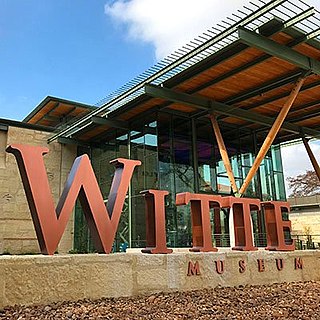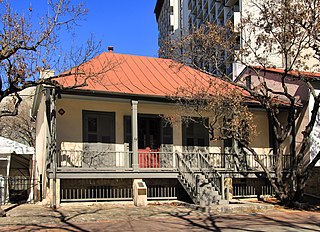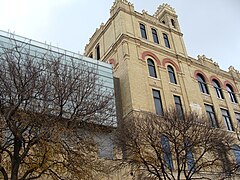
The Alamo is a historic Spanish mission and fortress compound founded in the 18th century by Roman Catholic missionaries in what is now San Antonio, Texas, United States. It was the site of the Battle of the Alamo in 1836, a pivotal event of the Texas Revolution in which American folk heroes James Bowie and Davy Crockett died. Today it is a museum in the Alamo Plaza Historic District and a part of the San Antonio Missions World Heritage Site.

The Pabst Brewing Company is an American company that dates its origins to a brewing company founded in 1844 by Jacob Best and was, by 1889, named after Frederick Pabst. It is currently a holding company which contracts the brewing of over two dozen brands of beer and malt liquor: these include its own flagship Pabst Blue Ribbon, as well as brands from now defunct breweries including:

The Menger Hotel is a historic hotel located in downtown San Antonio, Texas, USA, on the site of the Battle of the Alamo.

The Pearl Brewing Company was an American brewery established in 1883 in Downtown San Antonio, Texas, United States. In 1985, Pearl's parent company purchased the Pabst Brewing Company and assumed the Pabst name.
The Texas Transportation Company was an electrified, Class III, short-line railroad in San Antonio, Texas, that operated from 1897 until 2001. It served the Pearl Brewery and several other businesses, moving carloads between those businesses and the Southern Pacific yard. Service ended on June 30, 2000, shortly before the Pabst Brewing Company closed the Pearl Brewery, in early 2001.

The Spanish Governor's Palace is a historic adobe from the Spanish Texas period located in Downtown San Antonio.

The culture of San Antonio reflects the history and culture of one of the state's oldest and largest cities straddling the regional and cultural divide between South and Central Texas. Historically, San Antonio culture comes from a blend of Central Texas and South Texas (Southwestern) culture. Founded as a Spanish outpost and the first civil settlement in Texas, San Antonio is heavily influenced by Mexican American culture due to Texas formerly being part of Mexico and, previously, the Spanish Empire. The city also has significant German, Anglo, and African American cultural influences. San Antonio offers a host of cultural institutions, events, restaurants and nightlife in South Texas for both residents and visitors alike.

The San Antonio Museum of Art (SAMA) is an art museum in Downtown San Antonio, Texas, USA. The museum spans 5,000 years of global culture. The museum is housed in the historic former Lone Star Brewery (1886) on the Museum Reach of the San Antonio River Walk. Following a $7.2 million renovation, it opened to the public in March 1981.

The Witte Museum was established in 1926 and is located in Brackenridge Park in San Antonio, Texas. It is dedicated to telling the stories of Texas, from prehistory to the present. The permanent collection features historic artifacts and photographs, Texas art, textiles, dinosaur bones, cave drawings, and Texas wildlife dioramas, in addition to nationally acclaimed traveling exhibits. Artwork in the collection includes sculpture by San Antonio-born Bonnie MacLeary.

The Lone Star Brewery, built in 1884, was the first large mechanized brewery in Texas. Adolphus Busch, of Anheuser-Busch, founded it along with a group of San Antonio businessmen. The castle-like building which was once its brewery now houses the San Antonio Museum of Art. Lone Star beer was the company's main brand. The beer is still marketed as "The National Beer of Texas." The Lone Star name is now owned by Pabst Brewing Company. Production of Lone Star is currently contracted out to Miller Brewing Company in Fort Worth. The Lone Star name is used in the Philippines under license to Asia Brewery for a brand of light beer.

Alfred Giles was a British architect who emigrated to the United States in 1873 at the age of 20. Many of the private homes and public buildings designed by Giles are on the National Register of Historic Places and have been designated Recorded Texas Historic Landmarks. Based in San Antonio, his buildings can be found predominantly in south Texas and northern Mexico. Giles is credited with "a profound influence on architecture in San Antonio."

The Carl Wilhelm August Groos House is located in the Bexar County city of San Antonio in the U.S. state of Texas. It was designated a Recorded Texas Historic Landmark in 1977. Designed by Alfred Giles in 1880, the building contractor was John H. Kampmann. Giles used a Victorian Gothic Revival on this limestone home. Groos had immigrated from Germany to Texas in 1848, at which time he and his brothers started a freighting firm. In 1871, he built the Carl W. A. Groos House in New Braunfels. In 1872, he and his family settled in San Antonio. Groos married Hulda Amalie Moureau and became a founding member of the Groos National Bank. In 1880, Groos hired Giles to build his San Antonio home. It is listed on the National Register of Historic Places listings in Bexar County, Texas as a contributing structure of the King William Historic District. Groos died in 1893. In 1957, the house was purchased by the San Antonio Council of the Girl Scouts of the USA. The Girl Scouts sold the home to Charles Butt. It has been restored and is in private ownership.

The Buckhorn Saloon & Museum is a privately run museum located at 318 E. Houston Street in Downtown San Antonio, Texas, U.S. Originally privately owned by Albert Friedrich, the Buckhorn became a tourist attraction for its unique collections. Theodore Roosevelt and his Rough Riders were reputed to frequent the establishment. Housed in 1956 in the Old Lone Star Brewery, the collection passed to Friedrich's heirs who had it moved to its current location.

Casa Navarro is a historic site in San Antonio, Bexar County, in the U.S. state of Texas. The original house complex was the residence of Texas patriot José Antonio Navarro (1795–1871), a rancher, merchant, leading advocate for Tejano rights, and one of only two native-born Texans to sign the Texas Declaration of Independence. Navarro first bought the property, about 1.5 acres, in 1832. The limestone, caliche block, and adobe structures were built c. 1832–1855, and Navarro moved onto the property soon after.

The Edward Steves Homestead is located in the Bexar County city of San Antonio in the U.S. state of Texas. It was designed by architect Alfred Giles and designated a Recorded Texas Historic Landmark. The main house was donated to the San Antonio Conservation Society in 1952. The organization completely restored the main house as a museum and now conducts daily tours. The complete homestead property consists of four individual structures: the main house museum, the carriage house, the river house, and the servants' quarters. It is listed on the National Register of Historic Places listings in Bexar County, Texas, as a contributing structure of the King William Historic District.

The Jeremiah Dashiell House is located in the Bexar County city of San Antonio in the U.S. state of Texas. Also known as Casa Villita, it was designated a Recorded Texas Historic Landmark under that name in 1962. It is listed on the National Register of Historic Places listings in Bexar County, Texas as a contributing structure of the La Villita Historic District.

The San Antonio Municipal Auditorium was a building located at 100 Auditorium Circle, San Antonio, Texas. It was built as a memorial to American soldiers killed in World War I.

The O. Henry House Museum is a historic house museum located in San Antonio, Texas. It is named for the American writer, William Sydney Porter, better known by his pen name O. Henry, who lived in the house in 1885.
The King William Historic District of San Antonio, Texas was listed on the National Register of Historic Places listings in Bexar County, Texas on January 20, 1972. The area was originally used as farm acreage by the Spanish priests of the Misión San Antonio de Valero, and eventually parceled off for the local indigenous peoples of the area. In addition to residential homes, the district also includes the King William Park and Bandstand originally built in 1892 on the arsenal grounds, and later moved to its current location. Other features are the Upper Mill Park, the King William River Walk, and the Johnson Street pedestrian bridge.




















